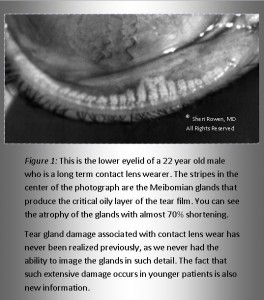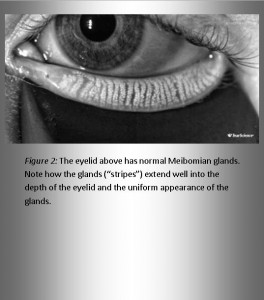Which came first, LASIK or Dry Eye?
by Guy M. Kezirian, MD, MBA, FACS and Sheri Rowen, MD, PCEO, FACS
January 2016
Conventional wisdom holds that LASIK causes dry eyes. New research suggest that may be backward thinking.
LASIK is not a common cause of dry eyes, but people with dry eyes often come in to have LASIK. When their dry eyes persist after their LASIK is done they blame the LASIK as the cause. In fact, several studies have shown that the dry-eye symptoms that some patients have after LASIK nearly always resolve within a few months.
The reality is the opposite – many patients come to have LASIK when they can no longer tolerate contact lenses, and dry eye conditions are a very common cause of contact lens intolerance. New technology has made it possible to obtain clear images of critical tear glands located in the eyelids.
The images below show destruction of the glands in a patient with contact lenses. The association between contact lenses and dry eyes is clear and research into the way that contact lenses modify the eye’s biofilm and obstruct gland openings is ongoing.
The result is dry eyes, contact lens intolerance, and then a decision to have LASIK. The tear film is already impaired – but symptoms may persist for years, especially if left untreated.


The amount of damage present guides the treatment approach. For early contact lens users, these glands may still be in good shape, so early LASIK will prevent further deterioration. For those who have been in contacts for some time, it is often necessary to use eyelid treatments to restore function to the tear glands. Here, modern technology can make a real difference. Once the tear film is restored, LASIK or other refractive procedures can be offered with minimal to no risk of dry eye problems after surgery.
Meibomian gland damage is only one cause of dry eye symptoms. State-of-the-art centers match dry eye treatments to the specific cause:
- When the problem originates with damage and loss of the Meibomian glands as shown above, Lipiflow treatments use heat and thermal pulsation pressure to restore healing blood flow and clear out stopped glands. Treatments are applied in the doctor’s office and are very effective.
- When the problem originates with inflammation, such as chronic allergies or arthritis conditions, the treatment is often drops such as Restasis that suppress inflammation and allow cells to heal. Most causes of dry eyes are also associated with inflammation. Doctors will prescribe Restasis drops and may use multiple therapies together.
- With dry eyes caused by a lack of sufficient moisture, stopping smoking, dietary change and increasing fluid intake can make a big difference.
For all conditions, stopping contact lens use and starting on omega-3 dietary supplements such as PRN (Physician Recommended Nutraceuticals) is essential. Your ophthalmologist and dry eye specialist can diagnose the cause and recommend the best treatment plan.
Finding a “no contacts” solution for vision correction should always be part of the dry-eye treatment plan. Refractive surgery is often the best treatment for dry eyes. Instead of causing dry eyes, LASIK can be an important part of the cure!

